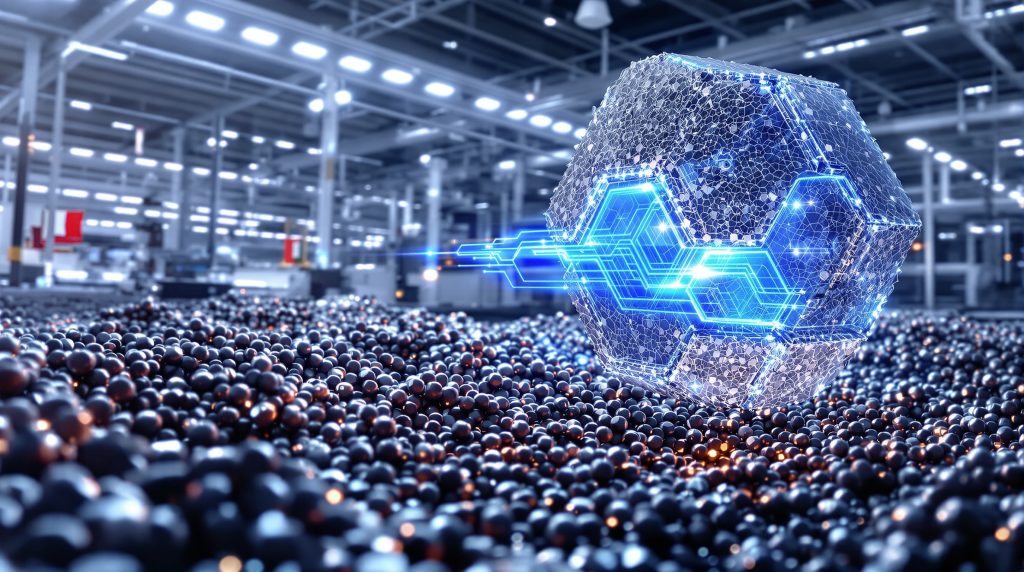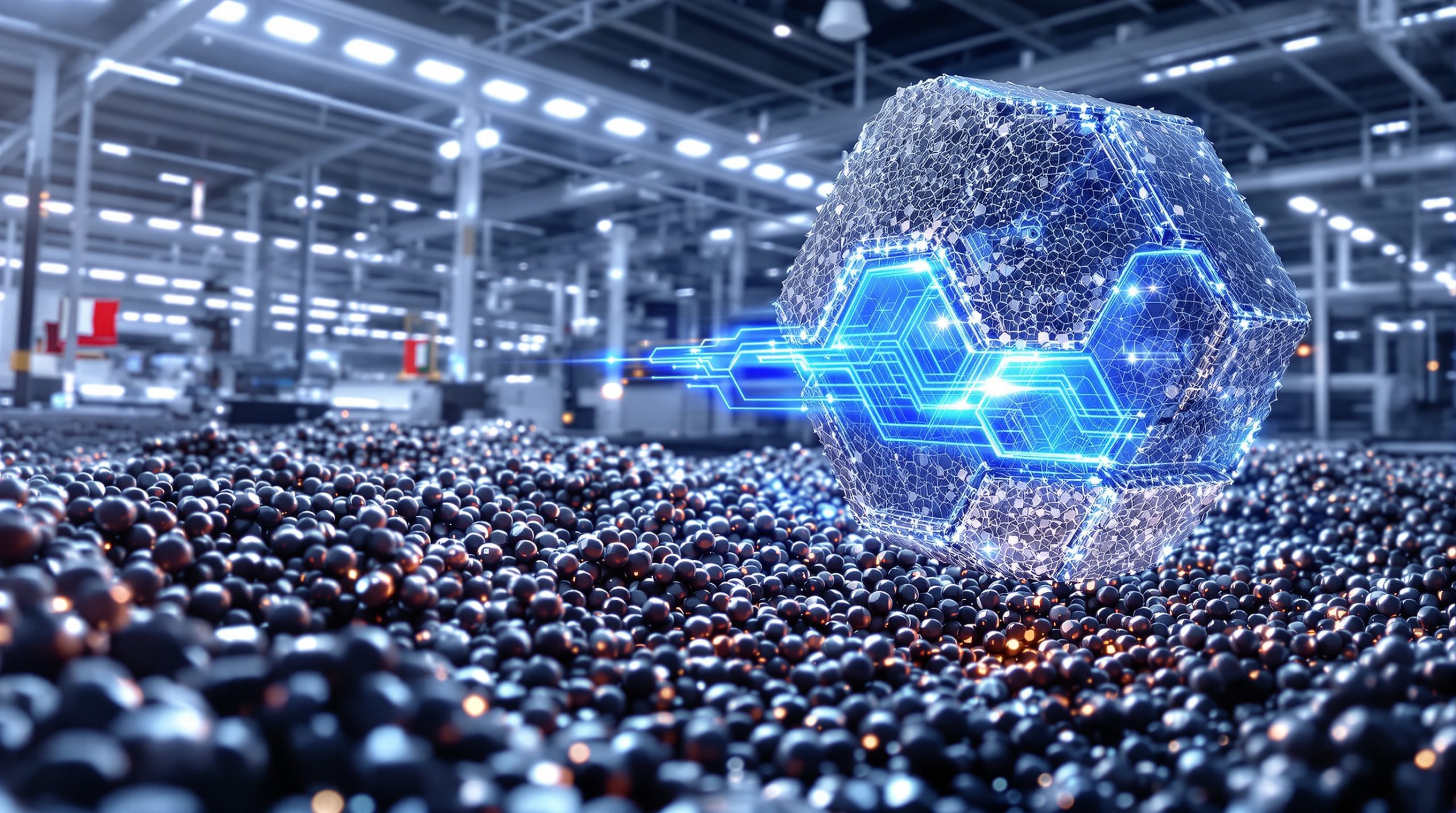The Strategic Importance of Graphite Anode Production
Graphite anodes represent approximately 95% of a lithium-ion battery's anode material and contribute about 35% of the total battery weight. This critical component serves as the foundation for energy storage in electric vehicles, making graphite anode plants strategic assets in the global energy transition.
As demand for EVs continues to accelerate, establishing secure supply chains outside China's dominant position has become a priority for automotive manufacturers and governments worldwide. With China controlling over 90% of graphite anode processing capacity, diversification has become essential for supply chain security.
According to the U.S. Geological Survey, China produces approximately 65% of the world's natural graphite and dominates synthetic graphite production for batteries. This concentration creates significant vulnerabilities in the global battery metals investment.
Benchmark Mineral Intelligence has identified graphite as "the most critical of all battery materials" due to supply chain concentration concerns. This criticality underscores why new graphite anode plants are gaining strategic importance in regions seeking energy independence.
What Makes Graphite Anode Plants Critical Infrastructure?
The Battery Material Supply Challenge
Graphite has been identified as one of the most critical battery materials facing potential supply constraints. Unlike other battery materials, graphite requires specialized processing to transform raw material into battery-grade anode active material (AAM).
This processing capability has historically been concentrated in Asia, creating vulnerability in global supply chains. The multi-stage transformation process—including spheroidization, purification, coating, and heat treatment—requires specialized technical expertise that has been limited outside of established production centers.
The U.S. Inflation Reduction Act has accelerated demand for domestic or allied-nation sourcing of battery materials, further highlighting the strategic importance of developing graphite anode plants in Western countries.
Regional Production Capacity Imbalance
Current global production of graphite anode materials remains heavily concentrated, with over 90% of processing capacity located in China. This concentration presents significant geopolitical and supply chain risks for Western automotive manufacturers and battery producers.
The imbalance is particularly problematic as battery manufacturing capacity expands rapidly in Europe and North America. Without local anode material production, these facilities will remain dependent on Asian imports, undermining the goal of supply chain resilience.
Recent supply chain disruptions have demonstrated the risks of over-reliance on single-region sourcing for critical minerals energy transition. Developing regional graphite anode facilities helps mitigate these risks while creating high-value manufacturing jobs.
How Are New Graphite Anode Facilities Being Developed?
Strategic Site Selection Criteria
Companies developing graphite anode plants prioritize several factors when selecting locations:
- Proximity to end markets or shipping infrastructure
- Access to reliable, affordable energy sources
- Availability of skilled labor
- Supportive regulatory environments
- Expedited permitting zones
- Existing industrial infrastructure
- Potential for future expansion
NextSource Materials' selection of Abu Dhabi Industrial City demonstrates this strategic approach, leveraging an existing industrial building in an expedited permit zone with minimal modification requirements. This site selection accelerates project timelines and reduces initial capital costs.
Vertical Integration Strategies
Leading graphite anode developers are pursuing vertical integration models that connect:
- Raw material mining operations
- Intermediate processing facilities
- Final anode material production
- Direct offtake agreements with battery manufacturers
This approach helps secure supply chains and provides greater quality control throughout the production process. NextSource exemplifies this strategy by connecting its Molo graphite mine in Madagascar to the planned Abu Dhabi processing facility, creating a vertically integrated supply chain.
Binding offtake agreements, such as NextSource's arrangement with Mitsubishi Chemical Group, provide financial security for these capital-intensive projects while guaranteeing supply for battery manufacturers.
What Technologies Drive Modern Graphite Anode Production?
Advanced Processing Methods
Modern graphite anode plants employ sophisticated multi-stage processing technologies:
| Processing Stage | Purpose | Technical Considerations |
|---|---|---|
| Spheroidization | Transforms flake graphite into spherical particles | Optimizes particle size distribution for battery performance |
| Purification | Removes impurities to achieve 99.95%+ carbon content | May use chemical or thermal methods with varying environmental impacts |
| Coating | Applies protective layers to enhance performance | Improves cycling stability and reduces first-cycle capacity loss |
| Heat Treatment | Establishes crystalline structure | Energy-intensive process requiring precise temperature control |
Each processing stage requires specialized equipment and expertise, contributing to the high capital costs of graphite anode facilities. Technological innovation in these areas focuses on improving efficiency, reducing energy consumption, and minimizing environmental impacts.
Environmental Considerations in Processing
Traditional graphite processing has faced criticism for environmental impacts, particularly when using hydrofluoric acid for purification. New facilities are increasingly adopting:
- Thermal purification methods
- Closed-loop water systems
- Renewable energy sources
- Waste heat recovery systems
- Carbon capture technologies
These environmental improvements help address concerns about the carbon footprint of battery materials while meeting increasingly stringent regulatory requirements in Western markets. Furthermore, the integration of sustainable mining practices has become essential for companies seeking to position themselves as responsible suppliers.
Where Are Major Graphite Anode Plants Being Developed?
Middle East Emerges as Processing Hub
The Middle East, particularly the UAE, has emerged as an attractive location for graphite anode production due to:
- Strategic positioning between Asian raw material sources and Western markets
- Established industrial infrastructure
- Competitive energy costs
- Expedited permitting processes
- Government support for battery material production
NextSource's $291 million Abu Dhabi facility exemplifies this trend, positioning the company to serve both European and Asian markets efficiently. The site's location in an expedited permit zone eliminates the need for environmental impact studies, accelerating the development timeline.
North American Production Expansion
Several projects are under development in North America, driven by:
- The Inflation Reduction Act's domestic content requirements
- Department of Energy funding support
- Growing domestic battery manufacturing capacity
- Automotive OEM demand for localized supply chains
These projects aim to create a resilient domestic supply chain for battery materials, reducing dependence on imports and supporting the growing EV manufacturing sector in North America. In addition, initiatives like the critical minerals reserve are helping to ensure long-term security of supply.
European Initiatives
European graphite anode development focuses on:
- Sustainable processing methods with lower carbon footprints
- Integration with regional battery gigafactory development
- Alignment with EU Battery Passport requirements
- Circular economy principles for material recovery
The European approach emphasizes sustainability and traceability throughout the battery supply chain, with graphite anode facilities designed to meet the region's stringent environmental standards.
What Economic Factors Drive Graphite Anode Plant Investments?
Capital Requirements and Project Economics
Developing commercial-scale graphite anode facilities requires significant investment:
- Initial capital expenditures typically range from $150-300 million for facilities producing 10,000-30,000 tonnes annually
- Payback periods generally fall between 4-6 years based on current market projections
- Internal rates of return typically range from 20-30% for well-structured projects
- Economies of scale significantly impact unit production costs
NextSource's Abu Dhabi project demonstrates these economics, with a post-tax net present value of $442 million, an internal rate of return of 24%, and a payback period under 5 years. The project's average sales price assumptions of $6,417 per tonne align with industry forecasts.
Offtake Agreements as Financial Foundation
Securing binding offtake agreements with established battery material suppliers or automotive OEMs has become essential for project financing. These agreements typically include:
- Minimum volume commitments
- Pricing mechanisms linked to market benchmarks
- Quality specifications and certification requirements
- Term lengths of 5-10 years
NextSource's agreement with Mitsubishi Chemical Group illustrates this approach, with the Japanese company committing to purchase 9,000 tonnes annually as its sole supplier of AAM for the North American EV market. This agreement provides a strong foundation for project financing while allowing additional capacity for future offtake arrangements.
How Are Graphite Anode Plants Addressing Sustainability Challenges?
Carbon Footprint Reduction Strategies
Leading graphite anode producers are implementing various approaches to reduce environmental impacts:
- Renewable energy integration for energy-intensive processes
- Advanced thermal management systems
- Water recycling and zero liquid discharge systems
- Development of non-hydrofluoric acid purification methods
- Co-location with renewable energy generation
These strategies help address concerns about the carbon intensity of battery material production, an increasingly important consideration for automakers seeking to reduce the lifecycle environmental impact of electric vehicles.
Traceability and ESG Compliance
Modern graphite anode facilities are implementing comprehensive tracking systems to:
- Document carbon footprint throughout the supply chain
- Verify ethical sourcing of raw materials
- Provide battery passport compliance data
- Support recycling and circular economy initiatives
These traceability mechanisms help meet regulatory requirements while addressing consumer and investor concerns about the environmental and social impacts of battery materials. Additionally, advancements in battery recycling breakthroughs are helping to create more sustainable lifecycle management for graphite materials.
What Does NextSource's Abu Dhabi Project Reveal About Industry Trends?
Project Specifications and Timeline
NextSource Materials' planned $291 million battery anode facility (BAF) in Abu Dhabi represents a significant development in the graphite supply chain:
- 30,000 tonnes annual production capacity of anode active material
- Two-phase development approach:
- Phase 1: $150 million investment for 14,000 tonnes annual capacity
- Phase 2: Expansion to full 30,000 tonnes capacity
- Initial production targeted for late 2026
- Full capacity expected by early 2028
This phased approach allows for initial production to meet existing offtake commitments while providing flexibility to expand as additional agreements are secured.
Strategic Advantages of the Abu Dhabi Location
The selection of Abu Dhabi's Industrial City provides several competitive advantages:
- Existing industrial building requiring minimal modification
- Location within an expedited permit zone
- No environmental impact study requirement
- Strategic positioning for serving both European and Asian markets
- Room for expansion beyond initial capacity
- Favorable energy costs for processing operations
These advantages highlight the importance of site selection in accelerating project development timelines and optimizing operational economics.
Financial Projections and Market Impact
The project's economic assessment demonstrates the financial viability of large-scale graphite anode production:
- Post-tax net present value of $442 million
- Internal rate of return of 24%
- Annual revenues of $195 million at full production
- Payback period under 5 years
- Average sales price assumptions of $6,417 per tonne
These projections, based on a 33-year operational life, indicate the long-term economic potential of graphite anode facilities when backed by strong offtake agreements.
Mitsubishi Chemical Offtake Agreement
The binding offtake agreement with Mitsubishi Chemical Group provides a strong foundation for the project:
- NextSource will be Mitsubishi's sole supplier of AAM for North American EV market
- Initial requirement of 9,000 tonnes annually
- Phase one capacity of 14,000 tonnes exceeds initial offtake requirements
- Additional capacity available for further offtake agreements
This arrangement demonstrates how strategic partnerships between material processors and established industry players can facilitate project development while securing critical supply chains.
How Will Graphite Anode Plants Impact Global Battery Supply Chains?
Diversification of Supply Sources
The development of graphite anode plants outside traditional manufacturing centers will:
- Reduce dependency on single-region supply
- Create redundancy in critical material supply chains
- Support compliance with domestic content requirements
- Enable regional battery manufacturing ecosystems
NextSource CEO Hanré Rossouw emphasized the facility's role in providing a "secure and traceable source of supply that is fully compliant with US government requirements for alternative sourcing," highlighting the strategic importance of supply chain diversification.
Price Stability and Competition
Expanded global production capacity is expected to:
- Moderate price volatility for battery-grade graphite
- Create more competitive market dynamics
- Accelerate innovation in processing technologies
- Drive efficiency improvements throughout the supply chain
As new facilities come online, increased competition may help stabilize prices while encouraging continuous improvement in processing technologies and quality standards.
Technical Performance Improvements
New graphite anode facilities are focusing on enhanced material properties:
- Higher capacity retention
- Improved fast-charging capabilities
- Extended cycle life
- Better low-temperature performance
- Reduced first-cycle capacity loss
These performance improvements are essential for next-generation batteries, requiring advanced processing capabilities and quality control systems.
What Challenges Do Graphite Anode Plant Developers Face?
Technical Expertise Limitations
Developing graphite anode plants requires specialized knowledge:
- Limited pool of experienced engineers and operators
- Proprietary processing technologies
- Complex quality control requirements
- Evolving battery manufacturer specifications
This knowledge gap presents a significant challenge for new entrants, often requiring partnerships with established technology providers or extensive recruitment from existing facilities.
Financing Hurdles
Despite strong market fundamentals, project developers face financing challenges:
- High upfront capital requirements
- Extended construction and commissioning periods
- Technology risk perceptions from traditional lenders
- Competition for capital with other battery material projects
NextSource's launch of a strategic partner process highlights these challenges, with the company seeking both debt and equity investors globally to fund construction.
Market Timing Considerations
Graphite anode plant developers must carefully time market entry:
- Aligning production capacity with battery gigafactory development
- Avoiding oversupply scenarios in specific regions
- Coordinating with upstream raw material development
- Anticipating technology shifts in battery chemistry
Successful projects require careful market analysis and flexible development timelines to match production capacity with evolving demand patterns.
What Does the Future Hold for Graphite Anode Production?
Technological Evolution
The graphite anode industry continues to evolve with:
- Development of silicon-graphite composite materials
- Advanced coating technologies for improved performance
- Artificial intelligence optimization of production processes
- Automated quality control systems
These technological advances promise to improve battery performance while potentially reducing production costs and environmental impacts.
Market Growth Projections
Industry forecasts suggest substantial growth in graphite anode demand:
- Global demand expected to triple by 2030
- Electric vehicle battery production driving primary demand
- Energy storage systems creating additional market growth
- Replacement batteries for aging EV fleets creating sustained demand
This projected growth underscores the strategic importance of establishing diverse, resilient supply chains for graphite anode materials.
Recycling Integration
Future graphite anode facilities will increasingly incorporate:
- Capabilities to process recycled graphite from end-of-life batteries
- Technologies to rejuvenate degraded anode materials
- Circular economy principles throughout the production process
As the first generation of EV batteries reaches end-of-life, recycling will become an increasingly important source of anode materials, complementing primary production. Leading companies like Graphinex are already integrating recycling capabilities into their production facilities.
The Strategic Value of Graphite Anode Plants
The development of graphite anode production facilities represents a critical component in securing battery supply chains for the energy transition. These facilities bridge the gap between raw material mining and battery cell manufacturing, providing the specialized processing capabilities essential for high-performance energy storage.
As projects like NextSource's Abu Dhabi facility demonstrate, the economics of graphite anode production are compelling, offering strong returns while addressing critical supply chain vulnerabilities. The two-phase approach to development, supported by binding offtake agreements, provides a model for future projects seeking to establish production capacity in strategic locations.
For regions seeking to establish domestic battery manufacturing capabilities, supporting graphite anode plant development should be considered a strategic priority. These facilities not only create high-value manufacturing jobs but also provide essential supply chain security for the automotive industry's transition to electric mobility.
With graphite representing approximately 95% of a lithium-ion battery's anode material and about 35% of the total battery weight, securing sustainable, reliable supplies of this critical material will remain a cornerstone of the global energy transition. As NextSource CEO Hanré Rossouw emphasized, these facilities play a vital role in "supporting the electric vehicle supply chain with vertically integrated, ESG-compliant solutions."
Want to Be First to Spot Major ASX Mineral Discoveries?
Discovery Alert's proprietary Discovery IQ model instantly notifies investors of significant ASX mineral discoveries, turning complex data into actionable insights that could lead to substantial returns. Visit Discovery Alert's discoveries page to explore historic examples of exceptional outcomes from major mineral finds.




